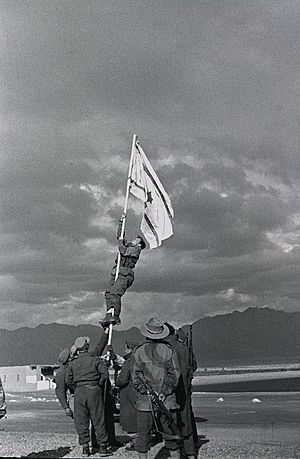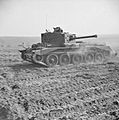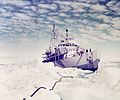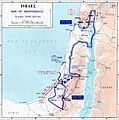1948 Arab-Israeli War facts for kids
Quick facts for kids 1948 Arab–Israeli War |
|||||||||
|---|---|---|---|---|---|---|---|---|---|
| Part of 1947–1949 Palestine war | |||||||||
 Captain Avraham "Bren" Adan raising the Ink Flag at Umm Rashrash (a site now in Eilat), marking the end of the war |
|||||||||
|
|||||||||
| Belligerents | |||||||||
|
Before 26 May 1948: Paramilitary groups: After 26 May 1948: Foreign volunteers: Mahal |
Irregulars: Foreign volunteers: |
||||||||
| Commanders and leaders | |||||||||
| Strength | |||||||||
| Israel: 29,677 (initially) 117,500 (finally) |
Egypt: 10,000 initially, rising to 20,000 Transjordan: 7,500–10,000 Iraq: 2,000 initially, rising to 15,000–18,000 Syria: 2,500–5,000 Lebanon: 1,000 Saudi Arabia: 800–1,200 (Egyptian command) Yemen: 300 Arab Liberation Army: 3,500–6,000. Total: 13,000 (initial) 51,100 (minimum) 63,500 (maximum) |
||||||||
| Casualties and losses | |||||||||
| 6,373 killed (about 4,000 fighters and 2,400 civilians) Around 2,000 were Holocaust survivors. | Arab armies: 3,700–7,000 killed Palestinian Arabs: 3,000–13,000 killed (both fighters and civilians) |
||||||||
The 1948 (or First) Arab–Israeli War was the second and final stage of the 1947–49 Palestine war. It began after the end of the British Mandate for Palestine, at midnight on 14 May 1948. The Israeli Declaration of Independence had been issued earlier that day. A military coalition of Arab states entered the territory of British Palestine in the morning of 15 May.
The first deaths of the war occurred on 30 November 1947: Two busses carrying Jews were ambushed. There had been tension and conflict between the Arabs and the Jews since the 1917 Balfour Declaration and the 1920 creation of the British Mandate of Palestine. Neither the Arabs nor the Jews liked British policies. The Arabs' opposition developed into the 1936–1939 Arab revolt in Palestine. The Jewish resistance developed into the Jewish insurgency in Palestine (1944–1947). In 1947, these tensions led to civil war . The United Nations Partition Plan for Palestine was adopted on 29 November 1947: it planned to divide Palestine into an Arab state, a Jewish state, and the Special International Regime for the cities of Jerusalem and Bethlehem.
One day after the Israeli declaration of independence, on 15 May 1948, the civil war transformed into a conflict between Israel and the Arab states. Egypt, Transjordan, Syria, and expeditionary forces from Iraq entered Palestine. These forces took control of the Arab areas and immediately attacked Israeli forces and several Jewish settlements. Ten months of fighting took place mostly on the territory of the British Mandate and in the Sinai Peninsula and southern Lebanon, interrupted by several truce periods.
As a result of the war, the State of Israel controlled the area that UN General Assembly Resolution 181 had recommended for the proposed Jewish state, as well as almost 60-percent of the area of Arab state proposed by the 1947 Partition Plan. This included the Jaffa, Lydda, and Ramle area, Galilee, some parts of the Negev, a wide strip along the Tel Aviv–Jerusalem road, West Jerusalem, and some territories in the West Bank. Transjordan took control of the rest of the former British mandate, which it annexed, and the Egyptian military took control of the Gaza Strip. At the Jericho Conference on 1 December 1948, 2,000 Palestinian delegates called for unification of Palestine and Transjordan as a step toward full Arab unity. The conflict triggered significant demographic change throughout the Middle East. Around 700,000 Palestinian Arabs fled or were expelled from their homes in the area that became Israel, and they became Palestinian refugees in what they refer to as Al-Nakba ("the catastrophe"). In the three years after the war, about 700,000 Jews emigrated to Israel, many of whom had been expelled from their previous homelands in the Middle East.
Images for kids
-
A "Butterfly" improvised armoured car of the Haganah at Kibbutz Dorot in the Negev, Israel 1948. The armoured car is based on CMP-15 truck. The car has brought supply to the kibbutz. The Negev Kibbutz's children were later evacuated by those cars from their kibbutz, before an expected Egyptian Army attack.
-
Mathematics professor Michael Fekete, the Provost of the Hebrew University of Jerusalem, with his water quota, during the siege of Jerusalem
-
Kaukji, the Arab Liberation Army commander
-
Northland in Greenland circa 1944 which became the Israeli INS Eilat
-
Israeli armoured vehicles in Lydda airport after the town's capture by Israeli forces
-
Arab prisoners of war captured by Israeli forces in Ramla.
-
Beit Horon Battalion soldiers in the Russian Compound in Jerusalem, 1948
-
IDF forces in Beersheba during Operation Yoav
See also
 In Spanish: Guerra árabe-israelí de 1948 para niños
In Spanish: Guerra árabe-israelí de 1948 para niños





























